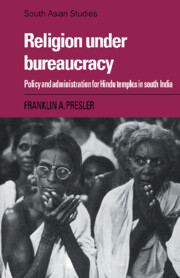Book contents
- Frontmatter
- Contents
- Dedication
- Preface
- Notes on sources, abbreviations and transliteration
- Map
- 1 Introduction: studying religion-state relations
- 2 The temple connection in the nineteenth century
- 3 Governance: the necessity for order
- 4 Governance: trustees and the courts
- 5 Economy: the problem of controlling land
- 6 Economy: the temple's weakness as landlord
- 7 Religion: purifying and organizing Hinduism
- 8 Religion: controlling the priesthood
- 9 Conclusion
- Bibliography
- Index
2 - The temple connection in the nineteenth century
Published online by Cambridge University Press: 03 October 2009
- Frontmatter
- Contents
- Dedication
- Preface
- Notes on sources, abbreviations and transliteration
- Map
- 1 Introduction: studying religion-state relations
- 2 The temple connection in the nineteenth century
- 3 Governance: the necessity for order
- 4 Governance: trustees and the courts
- 5 Economy: the problem of controlling land
- 6 Economy: the temple's weakness as landlord
- 7 Religion: purifying and organizing Hinduism
- 8 Religion: controlling the priesthood
- 9 Conclusion
- Bibliography
- Index
Summary
A little-recognized aspect of modern south Indian history is that the British colonial state penetrated Hindu religious institutions, both temples and maths (monasteries), deeply and systematically. This penetration was something that was neither unknown at the time nor unintentional. The state's relationship to the temple was formalized early in the nineteenth century and was a constant feature of the next century and a half of imperial rule. In form and intensity the state's activity varied over the years, but the Madras government consistently maintained that a measure of control was essential both for the state's security and income, and for society's welfare.
This fact is insufficiently noted in the historiography of British colonial rule in India. The general impression is that by the mid nineteenth century the British government had abandoned most policies which involved it directly with Hindu institutions, primarily as a result of pressure from Christian Evangelicals in England, reinforced later by the experience of the Indian Mutiny. This understanding of what happened has been advanced so many times in so many different contexts that it has become the standard interpretation of British colonial rule in India. In 1943, for example, a government committee took it as an established fact that “By 5th September 1843 the government parted with all control over religious institutions.”
It is true that the pressure in the nineteenth century to withdraw was enormous. A powerful coalition in England exerted unrelenting pressure on Parliament and the East India Company, and “withdrawal” became an ideology of great force. In time this pressure affected Madras, but the response of the local government was unenthusiastic, a mixture of resistance, reluctant accommodation and deception.
- Type
- Chapter
- Information
- Religion under BureaucracyPolicy and Administration for Hindu Temples in South India, pp. 15 - 35Publisher: Cambridge University PressPrint publication year: 1988



